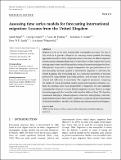Files in this item
Assessing time series models for forecasting international migration : lessons from the United Kingdom
Item metadata
| dc.contributor.author | Bijak, Jakub | |
| dc.contributor.author | Disney, George | |
| dc.contributor.author | Findlay, Allan M. | |
| dc.contributor.author | Forster, Jonathan J. | |
| dc.contributor.author | Smith, Peter W. F. | |
| dc.contributor.author | Wiśniowski, Arkadiusz | |
| dc.date.accessioned | 2019-03-25T12:30:08Z | |
| dc.date.available | 2019-03-25T12:30:08Z | |
| dc.date.issued | 2019-08 | |
| dc.identifier | 257702933 | |
| dc.identifier | 8ae7c178-2418-4fcf-90de-d4701d6b95e5 | |
| dc.identifier | 85063297105 | |
| dc.identifier | 000474259900008 | |
| dc.identifier.citation | Bijak , J , Disney , G , Findlay , A M , Forster , J J , Smith , P W F & Wiśniowski , A 2019 , ' Assessing time series models for forecasting international migration : lessons from the United Kingdom ' , Journal of Forecasting , vol. 38 , no. 5 , pp. 470-487 . https://doi.org/10.1002/for.2576 | en |
| dc.identifier.issn | 0277-6693 | |
| dc.identifier.other | RIS: urn:C5DF066686BD2D569396D78B0093B741 | |
| dc.identifier.uri | https://hdl.handle.net/10023/17365 | |
| dc.description | Funding: This work was funded by the Migration Advisory Committee (MAC), UK Home Office, under the Home Office Science contract HOS/14/040, and also supported by the ESRC Centre for Population Change grant ES/K007394/1. | en |
| dc.description.abstract | Migration is one of the most unpredictable demographic processes. The aim of this article is to provide a blueprint for assessing various possible forecasting approaches in order to help safeguard producers and users of official migration statistics against misguided forecasts. To achieve that, we first evaluate the various existing approaches to modelling and forecasting of international migration flows. Subsequently, we present an empirical comparison of ex post performance of various forecasting methods, applied to international migration to and from the United Kingdom. The overarching goal is to assess the uncertainty of forecasts produced by using different forecasting methods, both in terms of their errors (biases) and calibration of uncertainty. The empirical assessment, comparing the results of various forecasting models against past migration estimates, confirms the intuition about weak predictability of migration, but also highlights varying levels of forecast errors for different migration streams. There is no single forecasting approach that would be well suited for different flows. We therefore recommend adopting a tailored approach to forecasts, and applying a risk management framework to their results, taking into account the levels of uncertainty of the individual flows, as well as the differences in their potential societal impact. | |
| dc.format.extent | 18 | |
| dc.format.extent | 1672725 | |
| dc.language.iso | eng | |
| dc.relation.ispartof | Journal of Forecasting | en |
| dc.subject | International migration | en |
| dc.subject | Forecasting | en |
| dc.subject | Bayesian methods | en |
| dc.subject | ARIMA models | en |
| dc.subject | Uncertainty | en |
| dc.subject | Decision making | en |
| dc.subject | G Geography (General) | en |
| dc.subject | 3rd-NDAS | en |
| dc.subject.lcc | G1 | en |
| dc.title | Assessing time series models for forecasting international migration : lessons from the United Kingdom | en |
| dc.type | Journal article | en |
| dc.contributor.sponsor | Economic & Social Research Council | en |
| dc.contributor.institution | University of St Andrews. School of Geography & Sustainable Development | en |
| dc.identifier.doi | https://doi.org/10.1002/for.2576 | |
| dc.description.status | Peer reviewed | en |
| dc.date.embargoedUntil | 2019-03-22 | |
| dc.identifier.grantnumber | ES/K007394/1 | en |
This item appears in the following Collection(s)
Items in the St Andrews Research Repository are protected by copyright, with all rights reserved, unless otherwise indicated.

